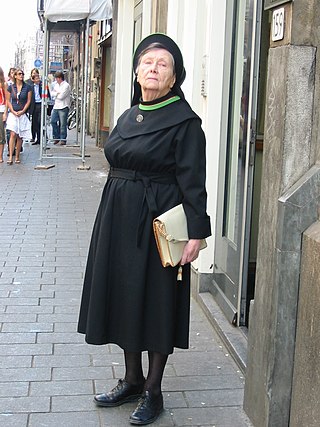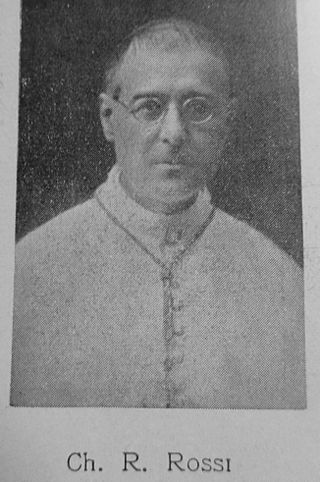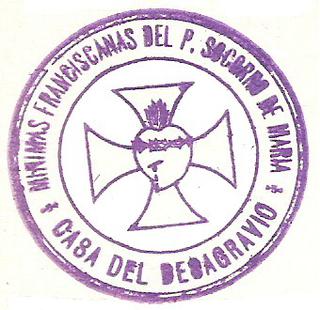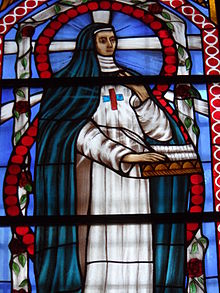
In the Catholic Church, a religious order is a community of consecrated life with members that profess solemn vows. They are classed as a type of religious institute.

The Trinitarians, formally known as the Order of the Most Holy Trinity and of the Captives, is a mendicant order of the Catholic Church for men founded in Cerfroid, outside Paris, in the late 12th century. From the very outset, a special dedication to the mystery of the Holy Trinity has been a constitutive element of the order's life.

The term third order signifies, in general, lay members of Christian religious orders, who do not necessarily live in a religious community such as a monastery or a nunnery, and yet can claim to wear the religious habit and participate in the good works of a great order. Roman Catholicism, Lutheranism and Anglicanism all recognize third orders.
The Daughters of St. Paul, also known as the Media Nuns, are an international Catholic religious congregation of consecrated women founded in 1915 in Italy.
A religious congregation is a type of religious institute in the Catholic Church. They are legally distinguished from religious orders – the other major type of religious institute – in that members take simple vows, whereas members of religious orders take solemn vows.

The Sisters of the Apostolic Carmel are members of a Carmelite religious institute dedicated to female education. It was founded in the latter part of the 19th century by Mother Veronica of the Passion, OCD, under the guidance of her mentor, Bishop Marie Ephrem of the Sacred Heart, OCD, who had envisioned the birth of "a Carmel for the missions" in India, devoted to teaching and education.
The Sisters of St. Joseph of Carondelet (CSJ) are a Roman Catholic congregation of women religious which traces its origins to a group founded in Le Puy-en-Velay, France around 1650 by Jean Pierre Medaille, S.J. The design of the congregation was based on the spirituality of the Society of Jesus. The Sisters of St. Joseph of Carondelet became a separate congregation of pontifical right on May 16, 1877.

The Discalced Carmelites, known officially as the Order of the Discalced Brothers of the Blessed Virgin Mary of Mount Carmel or the Order of Discalced Carmelites, is a Catholic mendicant order with roots in the eremitic tradition of the Desert Fathers. The order was established in the 16th century, pursuant to the reform of the Carmelite Order by two Spanish saints, Teresa of Ávila (foundress) and John of the Cross (co-founder). Discalced is derived from Latin, meaning "without shoes".
The Third Order of Saint Francis is a third order in the Franciscan tradition of Christianity, founded by the medieval Italian Catholic friar Francis of Assisi.

Augustinian nuns are the most ancient and continuous segment of the Roman Catholic Augustinian religious order under the canons of contemporary historical method. The Augustinian nuns, named after Saint Augustine of Hippo, are several Roman Catholic enclosed monastic communities of women living according to a guide to religious life known as the Rule of St. Augustine. Prominent Augustinian nuns include Italian mystic St. Clare of Montefalco and St. Rita of Cascia.

Raffaele Rossi, OCD, born Carlo Rossi,, was an Italian Discalced Carmelite and cardinal. Rossi served in the Sacred Consistorial Congregation in the Roman Curia from 1930 until his death and as a friar had the religious name "Raffaele of Saint Joseph". Pope Pius XI elevated him into the cardinalate in 1930. His cause of beatification began three decades after his death and he is known as a Servant of God.

The Council of Major Superiors of Women Religious (CMSWR) is one of two associations of the leaders of congregations of Catholic women religious in the United States. As of December 2020, CMSWR includes the leaders of 112 religious congregations which have a total membership of approximately 5,700 women religious in the United States.
The Secular Order of Discalced Carmelites, formerly the Secular Order of Discalced Carmelites of the Blessed Virgin Mary of Mount Carmel and of the Holy Mother Saint Teresa of Jesus, is a third order of Catholic lay persons and secular clergy associated with the Discalced Carmelites.

The Order of Atonement of the Franciscan Minims of the Perpetual Help of Mary (mfPS) is a single Roman Catholic active/contemplative religious order distinguished by three branches: the Men's Branch for priests and brothers/friars, the Women's Branch for nuns and the Lay Branch for those of all ages and professions, including the sick, dying, and those children conceived but as yet "unborn" or "pre-born".
The Congregation of the Mother of Carmel (C.M.C.) is a Syro-Malabar Catholic centralized religious institute of consecrated life of Pontifical Right for women founded in 1866. It was the first native congregation for women in that church.

Blessed Maria Pia Mastena - born Teresa Maria - was an Italian Roman Catholic professed religious and the founder of the Religious Sisters of the Holy Face. Mastena fostered a deep devotion to the Holy Face of Jesus and tried to promote that devotion to others in her religious career as a nun. Mastena first desired the contemplative life but was denied this after she entered the convent since it was not a cloister. Instead she dedicated herself to teaching in several Italian cities after having left another convent and another religious order when she deemed contemplative life was not the life she felt God wanted for her. Her labors were dedicated instead to consolidating her new religious order which began to grow after World War II until her sudden death in 1951.

The Congregation Sisters of the Most Holy Trinity, also known as the Trinitarian Sisters of Valence, is a Roman Catholic religious congregation of religious sisters based in Lyon, France, founded in 1660.
The Comboni Missionary Sisters are a Catholic religious institute originally founded under the name Pie Madri della Nigrizia, translated as the "Pious Mothers of the Nigritia" or "The Devout Mothers of Africa". They are also known as the Missionary Sisters Pie Madre della Nigrizia or the Missionary Sisters of Verona,












